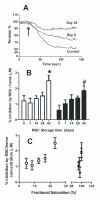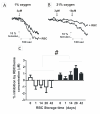Erythrocyte storage increases rates of NO and nitrite scavenging: implications for transfusion-related toxicity
- PMID: 22720637
- PMCID: PMC3572541
- DOI: 10.1042/BJ20120675
Erythrocyte storage increases rates of NO and nitrite scavenging: implications for transfusion-related toxicity
Abstract
Storage of erythrocytes in blood banks is associated with biochemical and morphological changes to RBCs (red blood cells). It has been suggested that these changes have potential negative clinical effects characterized by inflammation and microcirculatory dysfunction which add to other transfusion-related toxicities. However, the mechanisms linking RBC storage and toxicity remain unclear. In the present study we tested the hypothesis that storage of leucodepleted RBCs results in cells that inhibit NO (nitric oxide) signalling more so than younger cells. Using competition kinetic analyses and protocols that minimized contributions from haemolysis or microparticles, our data indicate that the consumption rates of NO increased ~40-fold and NO-dependent vasodilation was inhibited 2-4-fold comparing 42-day-old with 0-day-old RBCs. These results are probably due to the formation of smaller RBCs with increased surface area: volume as a consequence of membrane loss during storage. The potential for older RBCs to affect NO formation via deoxygenated RBC-mediated nitrite reduction was also tested. RBC storage did not affect deoxygenated RBC-dependent stimulation of nitrite-induced vasodilation. However, stored RBCs did increase the rates of nitrite oxidation to nitrate in vitro. Significant loss of whole-blood nitrite was also observed in stable trauma patients after transfusion with 1 RBC unit, with the decrease in nitrite occurring after transfusion with RBCs stored for >25 days, but not with younger RBCs. Collectively, these data suggest that increased rates of reactions between intact RBCs and NO and nitrite may contribute to mechanisms that lead to storage-lesion-related transfusion risk.
Figures








References
-
- Biffl WL, Moore EE, Offner PJ, Ciesla DJ, Gonzalez RJ, Silliman CC. Plasma from aged stored red blood cells delays neutrophil apoptosis and primes for cytotoxicity: abrogation by poststorage washing but not prestorage leukoreduction. J Trauma. 2001;50:426–431. discussion 432. - PubMed
-
- Zallen G, Offner PJ, Moore EE, Blackwell J, Ciesla DJ, Gabriel J, Denny C, Silliman CC. Age of transfused blood is an independent risk factor for postinjury multiple organ failure. Am J Surg. 1999;178:570–572. - PubMed
-
- Weinberg JA, McGwin G, Jr., Griffin RL, Huynh VQ, Cherry SA, 3rd, Marques MB, Reiff DA, Kerby JD, Rue LW., 3rd Age of transfused blood: an independent predictor of mortality despite universal leukoreduction. The Journal of trauma. 2008;65:279–282. discussion 282-274. - PubMed
-
- van de Watering L. Red cell storage and prognosis. Vox Sang. 2011;100:36–45. - PubMed
Publication types
MeSH terms
Substances
Grants and funding
LinkOut - more resources
Full Text Sources

